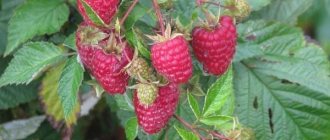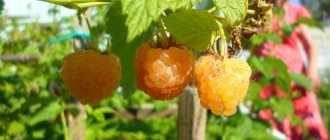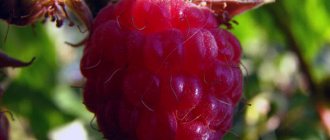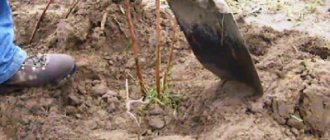Description of Apricot Raspberry
Apricot raspberries are considered the most productive among the remontant yellow varieties. The fruits of this variety are vaguely reminiscent of apricot in taste and color, which is why raspberries got their name.
This variety can be distinguished by the following characteristics:
- The slightly spreading bush produces 5-6 new shoots annually.
- The shoots are straight with a characteristic waxy coating, 1.3-1.6 m high, with a large number of branches directed upwards. The color of the new stem is green, the old one is brown.
- The spines are thin, underdeveloped, curved towards the ground. Located at the bottom of the stem. Towards the top they gradually disappear.
- The leaf is green, medium in size, openwork, slightly wrinkled, with a sharp apex.
- The flowers are white, medium in size.
- The berries are conical, with a blunt apex, color from bright yellow to pinkish-amber, weight - 3-3.5 g, with a small number of hairs, sweet with a characteristic sourness.
- The drupes are small, tightly knit, the flesh is juicy and soft.
Interesting! Tasters rated the taste of Apricotova at 4.5 points out of 5.
Planting raspberries of the Apricot variety
Site selection
Remontant raspberries, which include the Apricot variety, do not require any special care, but for a bountiful harvest you still need to follow certain rules and recommendations.
Yellow raspberries of the Apricot variety are quite demanding regarding the place and time of planting. Typically, seedlings are planted in the fall before the onset of cold weather; if for some reason this was not possible, the planting is postponed to spring. Raspberries will also take root, but will not please you with a large harvest.
The raspberry garden is located on the south side, where there is enough sunlight. Windy areas should be avoided. It’s good if there are small buildings nearby that provide protection from drafts.
Seedlings will not take root in swampy soil, despite their moisture-loving nature. The soil should be loosened and fertile.
Landing
First of all, you need to buy a healthy and strong seedling. It is necessary to carefully examine the root system and make sure that it is not overdried and without damage. In addition, you need to examine the buds; ideally there should be 5-6 of them on one plant.
It is not recommended to purchase seedlings in dubious places; now there are a lot of specialized nurseries where you can get a strong and healthy plant.
How to plant remontant raspberries of the Apricot variety:
- Make a hole about 35 centimeters in diameter.
- Add organic fertilizers. To do this, mix humus, a kilogram of ash and a couple of tablespoons of superphosphate with the soil.
- Be sure to prune the seedling, removing diseased buds and dry roots.
- Form a small hill inside the hole and place the future raspberry bush on it.
- Spread the root system around the hill and cover it with good soil.
- Carefully compact the soil around the base.
- Leave a few centimeters of the hole empty, so the water will not spill over the entire surface.
More on the topic: The newest varieties of non-repairing raspberries
The last step is to thoroughly pour the raspberries in two batches for maximum saturation with moisture.
Advantages and disadvantages
Despite being sun and moisture dependent, Apricot raspberries are becoming increasingly popular due to the unusual appearance and taste of the fruit. Also, the undeniable advantages of the Apricot variety are:
- frost resistance;
- resistance to diseases and pests;
- fruiting zone - 60-70% of the shoot;
- attractive appearance, large size, excellent taste of berries;
- hypoallergenic fruits.
But this variety also has quite a few disadvantages:
- mandatory compliance with the watering regime;
- with a lack of sun, the sourness of the berries increases;
- not all berries have time to ripen before frost;
- ripened fruits fall off;
- not intended for long-term storage;
- poor transportability.
Interesting! Due to the tendency of ripe berries to fall apart, Apricot raspberries are popularly nicknamed “loose”.
Reviews
I bought “apricot” raspberry seedlings on the advice of a seller at the market. A very unusual variety. The aroma of the berries is indeed apricot. The taste is somewhat peculiar, sweet and sour. I don’t think that this variety can replace all the raspberries in the garden, but it’s worth growing. I like both fresh berries and jam and jam made from apricot.
Tasty and somewhat unusual raspberries, since they don’t have that beloved smell. I reap abundant harvests. I consider the variety more suitable for harvesting than for fresh consumption due to its pronounced acidity. I will not plant more than the 20 bushes already available. I leave room for gourmet rather than dessert varieties.
The unusual Apricot raspberry variety has taken its rightful place among the popular varieties. Because of its sourness, it is often used to obtain berries for processing.
Landing
It is better to carry out the procedure in the fall, then the next season the raspberries will produce a bountiful harvest. When planting seedlings in spring, the first berries appear in the fall.
This variety needs to be allocated a sunny area, protected from drafts. The best solution would be a place behind an outbuilding so that its walls protect the bushes from the wind. The area is dug deeply, carefully removing weeds with roots.
By purchasing seedlings from certified nurseries, the gardener receives a guarantee that the plant is healthy. When purchasing, you should pay attention that the seedling has 5-6 buds.
The root system of the hybrid is superficial, so holes or trenches for seedlings are dug to a depth of 35–40 cm. Add to half of the dug soil:
- a bucket of humus or compost;
- 0.5–1 kg of charcoal;
- 30–40 g of superphosphate.
All this is mixed and placed at the bottom of the hole in the form of a mound. In the trench, these proportions of fertilizers are observed for each linear meter. The work is carried out 2 weeks before planting the seedlings.
The shoots of this hybrid are branched. In order for raspberries to get enough sun, when planting between bushes, you need to maintain a distance of 0.6–0.7 m, row spacing should be at least 1.5 m.
Planting is carried out in the following sequence:
- Before planting, seedlings are cleaned of damaged, dry roots and leaves.
- The plant is placed on a mound, with the roots evenly distributed on the sides.
- The soil is poured over the roots in stages, lightly compacted with the palm of your hand.
- Control the location of the root collar at ground level.
- The soil near the bush is watered abundantly (10–20 liters per bush) and mulched with humus to protect it from drying out. In addition, mulch protects the seedling from early cold weather.
Reference! Seedlings with deeply buried roots develop slowly.
Landing Features
Apricot raspberries, although an unpretentious plant, still require compliance with basic agrotechnical standards. They also apply to planting seedlings in a new place.
Raspberry seedlings of any variety must be healthy, without damage to the root system. A good shoot contains at least 5 buds. Planting material can be obtained from mother raspberry bushes on the site or purchased from trusted sellers. For example, order seedlings from a nearby nursery or by mail from Becker, Gardens of the Urals, Gardens of Siberia.
Apricot raspberries can be planted at any time, but experience shows that autumn plantings bear fruit abundantly next season.
Preparing the bed
You should choose a well-lit place for raspberries. According to the rules, bushes are planted in the direction from north to south, so that each plant can be bathed in sunlight from morning to evening.
Groundwater should not be located high, otherwise the root system may die. Apricot raspberry loves fertile and loose soil, so before planting the soil is filled with nutrients. For each square meter contribute:
- a bucket of compost or humus;
- liter jar of wood ash;
- about 45 grams of phosphate fertilizers.
The soil is dug up and weed roots are removed. After this, trenches or pits are formed. The depth of the planting site should be at least 60 cm, and the width should be 5 centimeters greater than the root system. Before filling the soil, drainage from pebbles, old branches or currants must be placed at the bottom of the hole. Planting holes for raspberries should be 4-5 cm in diameter larger than the volume of the root system, and about 50-60 cm in depth.
Attention! Planting sites are prepared 14 days before planting so that the soil has time to settle.
Preparation of seedlings
When choosing raspberry seedlings, preference is given to healthy plants with well-developed roots. Any dry twigs or roots must be cut off. Before planting, it is advisable to soak raspberry shoots in Kornevin, sodium humate, or simply in a solution of wood ash. This will help the seedlings take root better.
Landing rules
Before planting Apricot raspberries, the pits or trenches are filled with water. When it is absorbed, make a mound in the center and “sit” the plant on it. After straightening, the root system should be around the mound and look straight down.
Sprinkle nutritious soil on top and compact it to remove air pockets around the roots. A bucket of water is poured onto each plant in two passes.
Advice! There is no need to bury Apricot raspberry seedlings deeply, so as not to provoke slow development.
As soon as the water is saturated, the surface is covered with mulch. It not only prevents moisture from evaporating, but also warms the root system.
Tips for planting raspberries of any variety:
Watering
The apricot variety does not tolerate overwatering. With excess moisture, the roots of the hybrid begin to rot and the berries become sour.
Certain rules must be followed:
- In rainy weather, there is no need to water Apricot raspberries.
- In dry summers, one abundant watering every 1.5-2 weeks is sufficient.
- The soil is moistened at the rate of 20–30 liters of water per bush.
- After watering, the soil must be mulched, which helps the moisture evaporate more slowly.
- The last abundant moisture-recharging watering is done after the autumn harvest.
Reference! To prevent water stagnation, some gardeners, when planting seedlings, place drainage made of gravel or tree bark at the bottom of the hole.
Fertilizer
Apricot raspberry bushes bear fruit twice per season. The soil in this mode is quickly depleted, so it needs periodic feeding:
- In the first year, raspberries are not fed. Fertilizers applied before planting are enough for the full development of the bush and the ripening of the first harvest.
- At the beginning of the growing season, to stimulate flowering and fruiting, the soil is fertilized with nitrogen-containing compounds (urea, an aqueous solution of bird droppings 1:20 or mullein 1:10). The same fertilizing is done before the second flowering.
- In early spring, complex mineral fertilizing is done with wood ash, potassium sulfate and superphosphate.
- After the autumn harvest, potassium-phosphorus compounds are added to strengthen the plants' immunity.
Important! Autumn fertilizing with nitrogen fertilizers is contraindicated, since stimulation of growth in winter disrupts the plant cycle.
Remontant raspberries: cultivation and care (video)
Remontant raspberries of this variety are very unpretentious and frost-resistant. In terms of winter hardiness, it is significantly ahead of the popular variety “Yellow Giant”. The absence of thorns in the upper part of the bush makes picking berries easier and more comfortable. The second time, fruiting is observed at an earlier date, so before the onset of frost there is an opportunity to collect more ripe berries. The harvested crop is perfect for making jam, which is not only tasty and aromatic, but also has a very beautiful, sunny color.
Trimming and garter
To maintain good yields on healthy bushes, it is necessary to prune raspberries:
- In the spring, sanitary pruning is carried out. Frozen, broken and damaged shoots are removed.
- The tops of the shoots are pruned by 15–20 cm in the spring to stimulate the germination of fruitful branches.
- In autumn, in preparation for winter, young, non-lignified stems and last year's shoots are cut off. The former will die in winter, and it is irrational to preserve the latter. In the third year they no longer bear fruit.
The hybrid requires a mandatory garter, since with a large harvest the bush may collapse. At the edges of each row, stakes are driven in. A thick wire is pulled between them in two rows. The shoots are tied to a wire in two places.
Rules of care
Apricot raspberries, like any other variety, respond well to regular watering, mulching, loosening, pruning and feeding.
All remontant raspberries bear fruit twice in one season, and if the first harvest is formed on last year's shoots, then the second harvest can be harvested from young shoots of the current year.
In the year of planting remontant raspberries, growing young shoots enter the fruiting phase by autumn. Such excellent productivity requires very high quality care.
Watering
Apricot raspberries produce excellent yields with abundant watering. But moisture should not be allowed to stagnate. This can lead to diseases of the root system and the appearance of pests.
In dry summers, plants must be watered, as this berry crop reacts very painfully to a lack of moisture.
In late autumn, abundant pre-winter watering is carried out, increasing moisture reserves before wintering the plants.
Trimming
This is an important event during which excess, fruit-bearing shoots and dried twigs are removed. Spring pruning of raspberries is necessary to shorten the shoots by 15-20 centimeters in order to speed up the formation of axillary shoots with peduncles.
All shoots of remontant raspberries must be cut off before the onset of cold weather, leaving small stumps that will be covered with snow in winter.
Garter
To create stable plantings of Apricot raspberries and preserve shoots from breakage, gartering is done. If the raspberries are planted in a trench, stakes are driven in along the edges and a thick wire is pulled between them in two rows and the shoots are tied to it.
Top dressing
Raspberry bushes of the Apricot variety, according to descriptions and reviews from gardeners, are demanding in terms of nutrition. Plantings are fertilized several times a season. In the spring, immediately after the snow cover has disappeared from the plants, urea must be added at the rate of 40 g per linear meter of raspberry trees.
More on the topic: Dwarf raspberry Groovy
The first time you can fertilize the plants with green infusion. Pull out the weeds and pour boiling water over them. After two days you can water the raspberries. Grass sludge is used as mulch.
Using mulch will reduce the number of watering, weeding and loosening, since mulching helps to avoid overgrowing raspberry plantings with weeds and retain moisture. To do this, you can use peat and straw.
During the season, especially during flowering and fruiting, it is good to water the bushes with an infusion of mullein or wood ash.
Mulching
An important procedure that solves several problems at once:
- nourishes the soil with micro- and macroelements;
- prevents rapid evaporation of moisture;
- prevents weed germination;
- acts as insulation in winter.
Humus and peat are used as nourishing and moisture-protective mulch. To protect against weeds and frost, peat and sawdust are popular.
Reference! Mulch is placed over the entire area in a layer of 5–10 cm.
Protection from diseases and pests
The hybrid is quite resistant to diseases and pests. For prevention and at the slightest suspicion, the following steps should be taken:
- to protect against weevils, raspberry beetles and stem flies, raspberry plantings are sprayed with insecticides (Aktara, Aktellik);
- against gray rot, rust, purple spot and chlorosis, the shoots are treated with fungicides and copper sulfate;
- Chemical compounds are ineffective against raspberry gall midge; affected shoots should be cut off at the root and burned.
You can increase the immunity of raspberries by the following measures:
- regularly weed and loosen the soil, destroying the habitat of pests and their larvae;
- cut off excess shoots, avoiding excessive thickening of plantings;
- immediately cut and burn damaged shoots;
- timely treat the soil and raspberry bushes with special means.
Important! Any treatment of raspberries with chemical compounds is carried out in the spring before flowering begins.
Reproduction methods
Apricot raspberries are propagated by root suckers and cuttings. The former are available in sufficient quantities. They are separated from the mother bush with a sharp shovel. Seedlings are planted in spring or late summer in the same way as cuttings from a nursery.
Propagation by cuttings proceeds according to the following scheme:
- A cutting with an underground part 12-15 cm long is cut from the shoot.
- They place him in a stimulator (Heteroauxin, Kornevin) for half a day.
- The aged cuttings are planted in fertilized soil or peat and covered with film.
- In early spring, rooted cuttings are planted in the soil on the site.
Reference! For cuttings, shoots pruned to thin out the raspberry tree are often used.
Reviews from gardeners
“Apricot” raspberries are memorable for the very beautiful, golden-apricot color of the ripe berry, which is distinguished by its large size and excellent dessert taste. According to gardeners, the yield with proper care is very high and exceeds 3 kg from each adult bush. The plants are quite compact, consist of several straight-growing shoots and do not take up much space in the garden. Fruiting covers more than 50% of the length of the shoots. Ripening begins in mid-August and is characterized as long.











